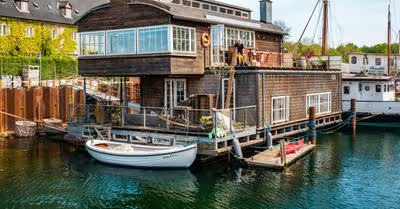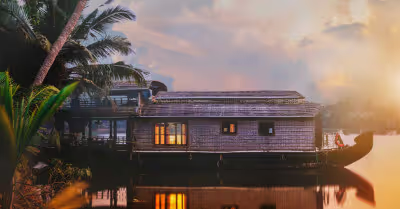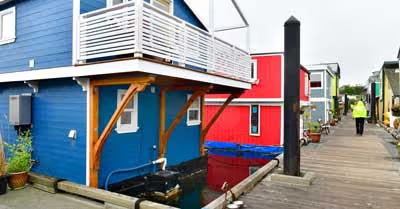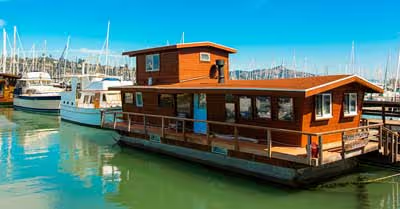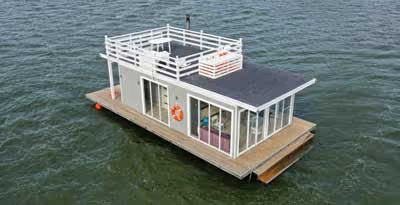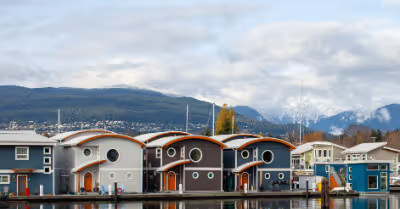
While living on a houseboat is great in the summer months, you need to know how to winterize a houseboat to protect it in the winter.
Winterizing a houseboat involves using antifreeze to protect the plumbing system, adding a stabilizer to the gas tank to reduce condensation in the tank, and using antifreeze to protect the engine. You should even block out any openings that rats and bugs can get in through.
While spending a few days or weeks on a houseboat has its challenges during winter, living on one takes the winterizing process to a whole new level, mainly because it gets more specific. This is because even the smallest hole can let in the chilling cold air, rodents, and other unwanted critters from outside.
The good news is that as experts, we can guide you on how to winterize your houseboat the right way. Whether you live on the boat in the winter or not, you can guarantee that come summertime, you'll have a properly working boat to come back to.
Why Should You Winterize a Houseboat?
Winterization is the process of safeguarding the various systems and equipment on a houseboat from damage caused due to freezing. Winterizing helps protect crucial components of a houseboat, such as the batteries, bottom units, and engines, from damage and wear that might occur when they are left idle during winter.
This also includes making efforts to make your houseboat as comfortable as possible so that it's liveable during cold winter months. Fortunately, all it takes is some effort to ensure your houseboat is secured throughout the harsh winter months. That being said, while winterizing a houseboat is, more often than not, a DIY project houseboat owners prefer to take on before winter each year, if you do run across something that you don't understand or aren't familiar with, just ask an expert (or read this article).
Winter is a time of dramatic climatic change, resulting in issues such as frozen plumbing systems (busted pipes), the fuel going bad over time, water freezing and breaking wood, and so on. As a result, every houseboat owner should be prepared for any issues that may develop during that period. It is for this reason that winterization is carried out. It is occasionally done when the resident of the house intends to leave it unoccupied for an extended length of time, and it does not have to be done right before winter. It should simply be completed before the winter season.
What about a Docked Houseboat?
People who park their houseboats in warmer locations during the winter and believe that winterization isn't necessary for their boats are mistaken. Winterization is essential whenever the boat will not be used for an extended time. Regardless of whether the temperature is warm or cold, wasted fuel spoils unless a stabilizer is added.
In a warm region, you may not need to put antifreeze in your water or sewage pipes, but there are still things you should do if you intend on not using your houseboat for an extended period.
There may be creatures, such as bugs or rodents, who can feel a change in seasons, even if it is not extremely drastic, which can also damage your houseboat.
Because mice are so little, they can hide in areas you wouldn't think to look. Make sure you've protected your houseboat against creatures like mice, bugs, and other pests. To keep these little creatures from getting into and remaining in your houseboat, make sure that all small spaces, such as holes, gaps, niches, and so on, are filled shut with something like steel wool. It would be much better if the wool was made of stainless steel.
If the holes or crevices are somewhat huge in comparison, you should adequately seal them. Even in warm regions, water left on the deck or in other locations might pose difficulties over time. Rust, rot, and other problems can arise as a result of standing water, so make sure to remove any standing water to avoid these concerns.
Winterizing the Plumbing System
Whether you're at home on solid ground or on a houseboat, the last thing you want is to be stuck with a leaking or frozen piping system. If you have a faucet or any other fixtures onboard that deliver water, whether it's raw or fresh, you'll need to add antifreeze to the system. Otherwise, the increasing ice within can cause hoses or pumps to shatter.
Make sure you have the right antifreeze before you begin. Look for what's known as "the pink stuff" at the local marine supply store. At this time of year, you'll probably see cases packed to the roof. This antifreeze is suitable for use in drinking water systems. Propylene glycol-based antifreeze is what you're looking for. Do not use ethylene glycol-based antifreeze in your car or engine. It is extremely harmful.
Because many plumbing systems are customized to the boat manufacturer, we recommend that houseboat owners contact their boatbuilders for winterizing advice tailored to their specific boat. Remove the freshwater tank's feed pipe and place it in antifreeze in a bucket. You can use a five-gallon capacity bucket. All that's left is to open each and every hot and cold fixture until antifreeze begins to flow.
Remember to reconnect your freshwater tank feed pipe after you're finished. Many people overlook the freshwater showers located on the swim platform on many vessels. Now, remove the raw-water line for each of the pumps from their closed supply seacock and immerse the hose end in a bucket full of antifreeze for raw-water systems like livewells or wash-downs. Each pump should be turned on until pink antifreeze begins to flow from each fixture.
Water that gathers in those tiny nooks and crannies may freeze, expand, and inflict costly damage as soon as temps dip into the low 30s. Keep limber holes free and ensure that water-collecting areas are well-drained. Your on-deck shower, for example, will not be used in the winter and should be one of the first areas to winterize so that you can enjoy it during the summer.
Use food-safe antifreeze to close off and winterize any section of the plumbing system that links to the drinking water system (such as a deck wash system you won't be using in the winter). Flushing isn't enough to get rid of dangerous substances.
Winterizing the Fuel System
When it comes to fuel supply and storage systems on boats, water is the enemy. This is especially true if you have an ethanol-blended fuel tank in your gasoline-powered boat. Diesel fuel has its own set of difficulties. Condensation becomes a concern when winter temperatures vary widely.
Traditionally, experts have advised that you store your boat with at least 95% of the fuel in the tanks. This is the case whether you are using gasoline or diesel-powered engines. This reduces the amount of air in the tank that might cause condensation and introduce moisture into the gasoline. However, because of the nature of ethanol, several manufacturers now provide alternative recommendations when it comes to gasoline-filled tanks.
Besides, leaving your boat full to the brim for more than two months may cause more harm than good. Instead, you might wish to drain it as much as possible, treat what's left in the tank, and refill it with new fuel next spring. Always, and we mean always, apply an adequate fuel stabilizer, regardless of the gasoline type. While diesel is more forgiving, neglecting to add stabilizer to ethanol-blend gasoline is always a recipe for disaster.
Fuel filters should also be changed now, especially if you have a stand-alone water/fuel separator filter. Onboard gasoline filters on inboard and outboard engines should be serviced according to the manufacturer's recommendations.
Winterizing the Air Conditioning
Another device that may come with winterizing requirements from the manufacturer is the air conditioning system you have installed in your houseboat. It is important to note that even if they don't, there are a few different schools of thought when it comes to the best approach to winterize an air conditioner.
You will start by injecting antifreeze throughout the air conditioning system. Shut the intake seacock before removing the supply line, soak it in antifreeze, and run the system until pink emerges from the overboard outlet. When you're finished, make sure to reconnect the hose. You will need to do the same for all air conditioning units installed on the houseboat to ensure that they are all safe during winter.
Winterizing the Houseboat's Engine
Water that freezes inside the engine's cooling tubes is the largest hazard to inboard boat engines in the winter. If you leave an engine unprotected for the winter, you should expect a hefty repair expense in the spring. Remove the raw-water intake line from its closed supply seacock, place it in a five-gallon pail of antifreeze, and run the engine until it flows out the exhaust outlet for winterizing any type of inboard engine.
This ensures that the antifreeze has passed through the internal cooling tubes of the engine as well as the exhaust components. That antifreeze, like the pink substance, should be created with propylene glycol. Make sure that it's compatible with engine use. The difference is that it contains corrosion inhibitors to save your engine's insides.
It's also a good idea to get into the habit of changing the filter and engine oil as part of your inboard winterizing routine. Leaving an outdated batch of oil in the engine can result in corrosion, water damage, and even death. In addition, gasoline inboards that will be sitting for a lengthy amount of time should be fogged. Apart from raw-water cooling and oil changes, you'll need to change the gear grease in the stern drive's lower unit on boats with sterndrives.
Cleaning Tips
Winterizing your home is also a great time to make sure that your houseboat is clean as well. Pull your anchor out of the water and clean the muck off the chain and rod. Clean the black sludge out of the scuppers with a scrub brush and send a young child inside the laundromat. Lay out your sails and lines on the grass to be washed in warm soapy water. Before storing them for the winter, make sure they are completely dry.
Now is the time to bring your sails or canvas to the sail loft for repairs. Cover the hole on the rear of your boom where the birds make their spring nest. Give her a good cleaning from front to back now that all of the stuff is out of the cabin. Clean the insides of the lockers and drawers. Lemon oil should be used to clean the wood. Remove all of the hairs from behind the ears. Clean the carpets and get the curtains cleaned.
Winterizing a Houseboat against Rats and Other Critters
We mentioned winterizing your houseboat against rats and other little critters. Even in warm climates like South Florida, bugs and rodents are aware of the changing seasons and are on the move. They wreak serious damage while gnawing their way inside your boat, and things only get worse after they've established themselves on board.
When it comes to insect remedies, be particularly cautious. Mice may squeeze through the smallest of openings, so keep any areas where rodents might be present secure. Increase the number of baits, traps, and/or rat guards used. Steel wool stuffed in tiny gaps where mice may enter is an ancient method. To avoid unsightly rust spots on a yacht, use stainless steel wool. Hardware cloth, which is frequently available in 1/8- to 1/4-inch sizes, can be used to plug larger holes.
The Right Time to Winterize a Houseboat
So, now that you are aware of the things you need to do to winterize your houseboat, the next obvious question is, when is the best time to winterize a houseboat?
You shouldn't have to worry about freezing outside until the temperature starts to drop. That said, use marine antifreeze in all of your exterior water lines by that time. It should also be noted that temperatures below freezing at night aren't always a cause for alarm. Your boat engines should be winterized if the temperature drops below freezing for three days and nights in a row. This isn't to say I'm not concerned when the temperature drops for two out of three days.
In my opinion, it's always better to be cautious than sorry. It should also be noted that because the water temperature is usually still warm during November and early December, the engine compartment may feel warmer than it actually is. So, to stay safe, once the temperature starts to dip below freezing for three consecutive days and nights, it's time to start winterizing your houseboat.



